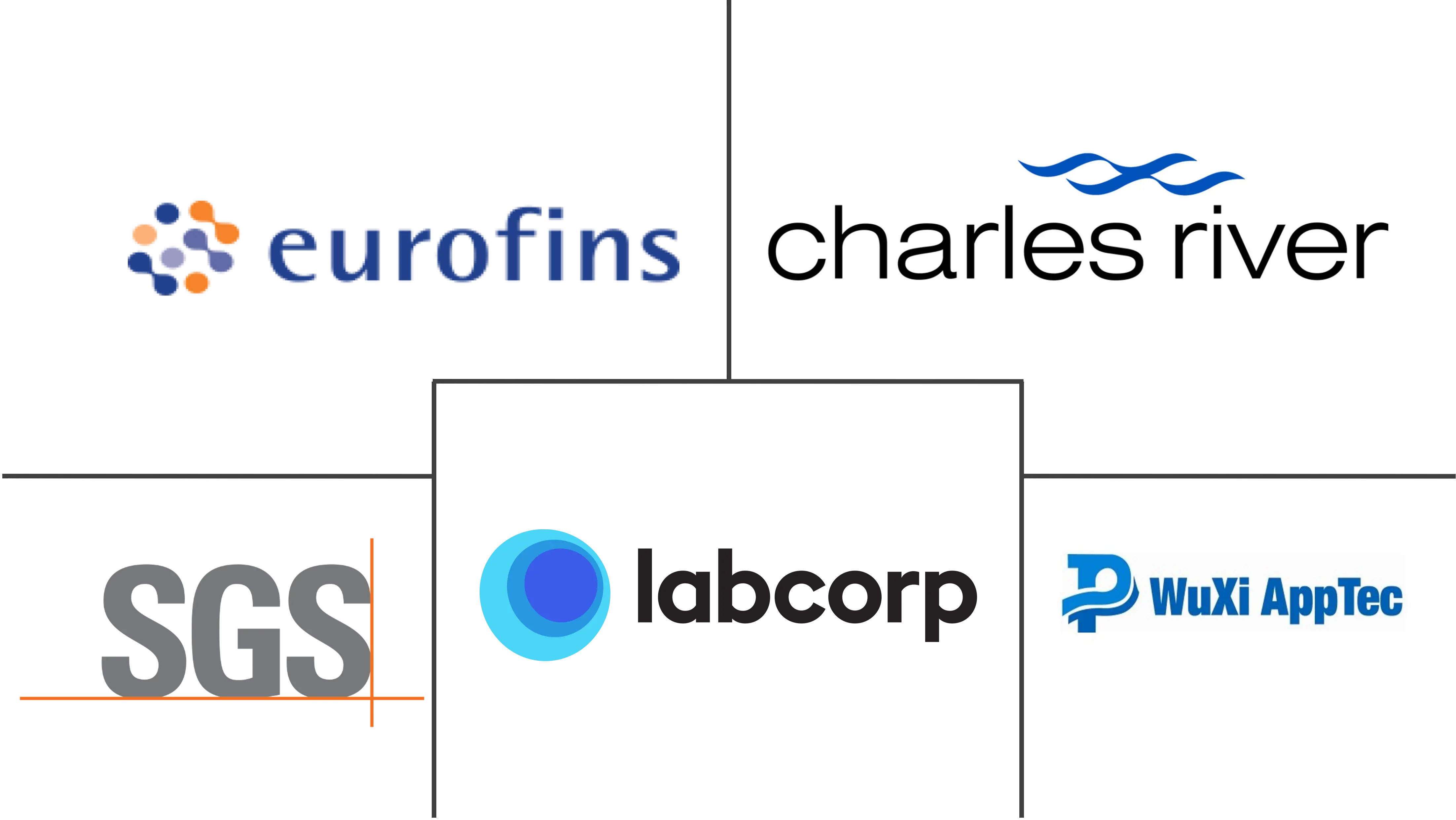Preclinical CRO Market Size and Share
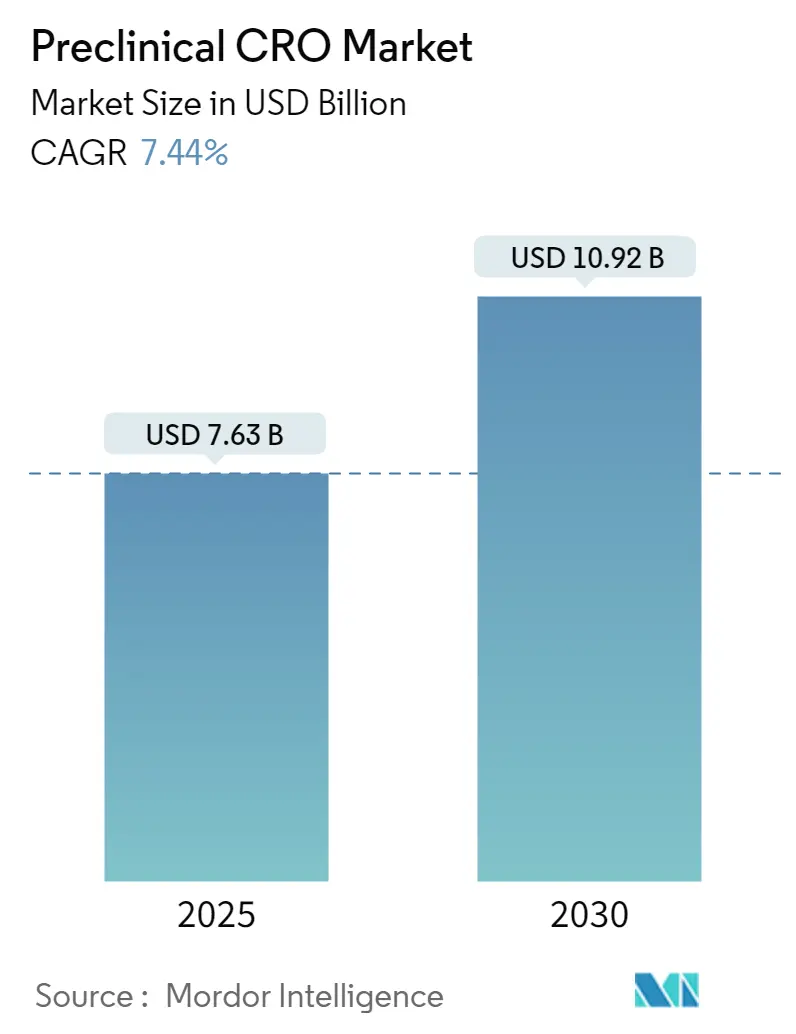
Preclinical CRO Market Analysis by Mordor Intelligence
The Preclinical CRO Market size is estimated at USD 7.63 billion in 2025, and is expected to reach USD 10.92 billion by 2030, at a CAGR of 7.44% during the forecast period (2025-2030). This growth is primarily driven by increasing research and development (R&D) expenditure worldwide, increasing the number of drugs in preclinical trials, and high demand for medicines uptake by chronically ill patients between 2025 and 2030.
Pharmaceutical companies are ramping up their research and development (R&D) spending to pioneer advanced treatments for various chronic diseases. This surge in R&D investment is driven by comprehensive drug discovery initiatives. These initiatives encompass not only the identification and development of potential chronic disease treatments but also the execution of preclinical studies, the design of clinical trials, and the navigation of regulatory approvals. For instance, in the Union Budget for 2023-2024, the Indian Ministry of Science and Technology earmarked INR 40 billion (USD 427.20 million) for the Department of Biotechnology (DBT). Out of this, an allocation of INR 11 billion (USD 130.48 million) was directed mainly towards biotechnology research and development, as well as fostering industrial and entrepreneurial growth in the nation.
This notable surge in funding is largely attributed to the escalating R&D expenditures across the country. Consequently, as R&D spending rises, there's an anticipated uptick in the adoption of preclinical CRO services, aimed at curtailing the overall costs associated with drug development.
As the number of drugs in preclinical stages rises, there's a growing trend to outsource preclinical services. This strategy aims to cut development costs and boost the likelihood of drug approval for subsequent clinical trials. For instance, data updated in January 2024 from ClinicalTrials.gov reveals that nearly 479,000 clinical studies were registered worldwide. This surge in clinical trials underscores the volume of therapeutics and medical devices that have successfully navigated preclinical trials and secured New Drug Application (NDA) approvals. Thus, with the uptick in drugs entering preclinical trials, the preclinical CRO industry is poised for growth in the coming years.
As the number of drugs in preclinical trials for diseases like cardiovascular issues and overactive bladder rises, the demand for preclinical CRO services is set to surge. This uptick aims to expedite the drug development process, thereby propelling the preclinical CRO market growth during 2024 to 2029. However, a lack of standardization and monitoring issues coupled with stringent regulatory policies are expected to hinder the market growth over the forecast period.
Global Preclinical CRO Market Trends and Insights
Toxicology Testing Segment is Predicted to Witness Significant Growth
By service, the toxicology testing segment is expected to see a a CAGR of 6.95% over the forecast period (2024-2029) while holding a significant preclinical CRO market share. Industry analysis says that the toxicology testing segment is expected to have a market value of USD 1.97 billion in 2024 and is likely to reach a market size of USD 2.76 billion by 2029.
Toxicology testing evaluates how chemical substances or pharmaceutical compounds might adversely affect living organisms. It employs various methodologies to determine the safety profile of these substances, particularly their potential for harm or toxicity. In the ever-evolving realm of pharmaceutical R&D, there's a notable rise in the demand for preclinical toxicology testing services from contract research organizations (CROs). This uptick is driven by several factors, notably the growing partnerships between pharmaceutical firms and CROs, alongside technological advancements that boost the efficiency and accuracy of toxicology testing.
Expanding partnerships between pharmaceutical companies and CROs is likely to drive the demand for toxicology testing services. As drug development efforts intensify, pharmaceutical companies increasingly rely on CROs for their expertise and infrastructure, especially for crucial preclinical toxicology studies. For example, in May 2023, Immuter collaborated with Charles River Laboratories for a Good Laboratory Practice (GLP) toxicology study on its proprietary candidate IMP761, targeting autoimmune diseases. Similarly, in March 2024, Badvus Research entered a strategic alliance with Southern Research, emphasizing preclinical toxicology testing and navigating regulatory approval processes. These partnerships highlight CROs' essential role in bolstering drug development and ensuring adherence to regulations through thorough toxicology evaluations.
Toxicology testing conducted by preclinical CROs is integral to drug development, allowing pharmaceutical firms to assess candidate safety profiles and make informed progression decisions. Thus, the growing collaboration between pharma companies and CROs is poised to boost the segment’s growth rate.
Consequently, a surge in drug development activities by pharmaceutical companies, coupled with technological advancements that boost the accuracy and efficiency of toxicity assessments, is fueling the rising demand for toxicology testing services in preclinical CROs. With the evolving collaborations between pharma firms and CROs, alongside technological progress, the realm of preclinical toxicology testing is set for further evolution, paving the way for safer and more effective therapeutic interventions in the pharmaceutical sector over the forecast period.
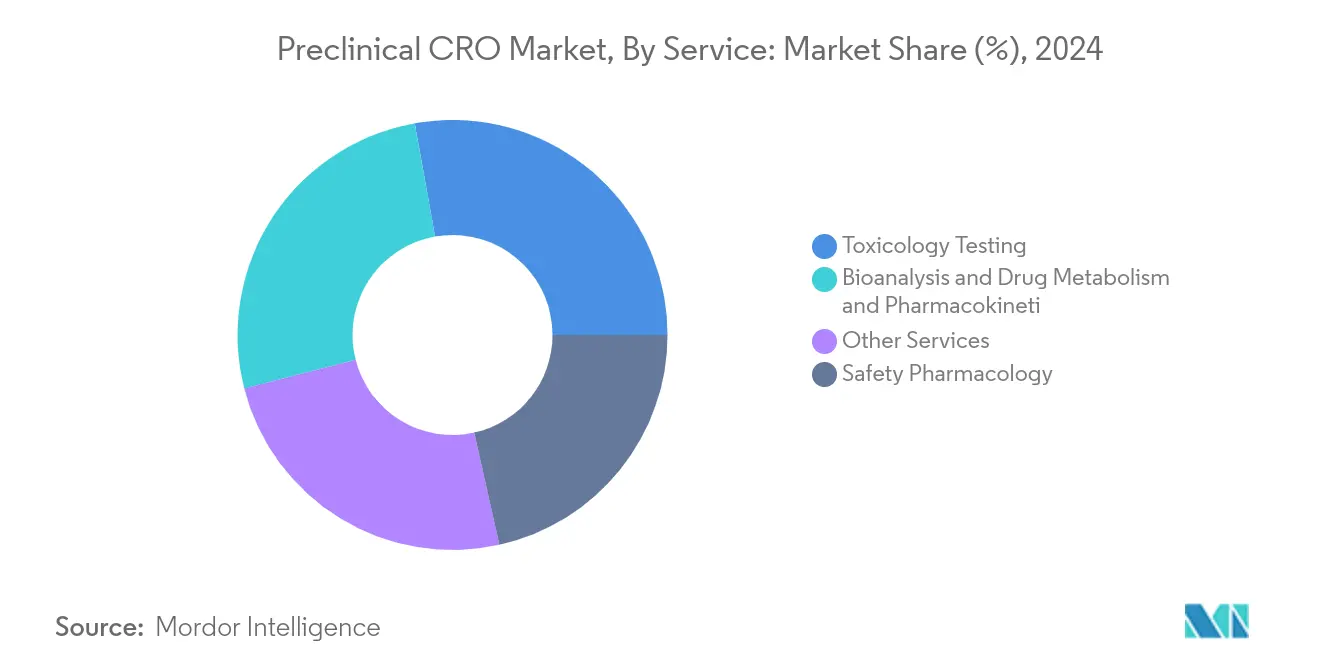
By Mode Type, Patient Derived Organoid (PDOs) Models Segment is Expected to Hold a Major Preclinical CRO Market Share during 2024 - 2029
Patient Derived Organoid (PDOs) Models in the mode type segment are expected to have a significant market share with a CAGR of 7.54% over the forecast period (2024-2029). Market forecast estimates that the patient derived organoid (pdos) models segment is expected to have a market value of 5.74 billion in 2024 and is likely to reach a market value of USD 8.25 billion by 2029.
Patient-derived organoid (PDO) models serve as a physiologically relevant platform for investigating disease mechanisms, assessing drug responses, and exploring personalized medicine strategies within a controlled laboratory environment. Key services leveraging PDO models encompass drug efficacy testing, drug screening, in vitro pharmacokinetic evaluations, drug toxicity assessments, anticancer drug discovery, and various tailored drug evaluations.
The preclinical CRO market is segmented by service, mode type, and end users. By service, the market is segmented into toxicology testing, bioanalysis and drug metabolism and pharmacokinetics studies, safety pharmacology, and other services. By mode type, the market is segmented into patient-derived organoid (PDO) models and patient-derived xenograft (PDX) models. By end users, the market is segmented into biopharmaceutical companies, research institutes and universities, and other end users. This comprehensive market segmentation enables CRO companies to strategically invest in key areas, optimizing their revenue shares.
North America Expected to Witness Significant Growth in the Preclinical CRO Market
By geography, the North America region is likely to hold a major preclinical CRO market share with an estimated market size of USD 2.63 billion in 2024, expected to reach USD 3.64 billion by 2029, with a CAGR of 6.71%. North America is expected to have the largest share throughout the forecast period due to the higher in-house drug development & discovery costs, increasing complexity in clinical trials, and a high number of investigational candidates in the development pipeline.
In addition, the rising burden of life-threatening chronic diseases and technological advancements in preclinical trials are further projected to support the region’s market growth over the forecast period.
The rising prevalence of chronic diseases, including cardiovascular ailments, diabetes, cancer, and neurological disorders, underscores the urgent need for new therapies and treatments. This evolving landscape compels pharmaceutical companies to outsource preclinical trials, aiming to identify promising candidates for these diseases. Such dynamics are projected to drive the country's market growth during the study period.
For instance, the American Cancer Society highlighted a concerning trend regarding lung cancer in January 2023; lung cancer cases in the country rose from 236,740 in 2022 to 238,340 in 2023. This uptick signals a rapid escalation in cancer incidences, with projections indicating a continued rise. Consequently, this mounting cancer burden is set to amplify the demand for advanced therapeutics, subsequently boosting preclinical trial activities and supporting America’s preclinical CRO industry growth throughout the study period.
Moreover, government legislation in Canada is actively promoting clinical trials, bolstering the country's market growth during the study period. For example, in January 2023, the Canadian Institutes of Health Research unveiled investments aimed at bolstering domestic research projects. Such government backing is anticipated to accelerate new drug developments in Canada, subsequently heightening the demand for preclinical CROs to advance these drugs into further clinical trials. Consequently, these governmental initiatives are poised to propel the market during the forecasted period.
Mexico boasts a robust regulatory framework for preclinical and clinical trials. COFEPRIS, the nation's regulatory authority, streamlines the approval process with clear guidelines and efficient reviews. This dependable regulatory landscape bolsters confidence among pharmaceutical firms and preclinical CROs, positioning Mexico as a prime choice for preclinical research.
In May 2023, COFEPRIS updated its guidelines for preclinical and clinical studies in Mexico. As the guardian of clinical trial safety in the nation, COFEPRIS's established framework is set to elevate Mexico's status as a top-tier destination for clinical trials, thereby fueling industry growth during the forecast period.
All the aforementioned factors, including the significant burden of chronic diseases, a complex regulatory framework, and numerous advancements, are poised to bolster the preclinical CRO market growth in North America throughout the forecast period.
By geography, the market is segmented into North America (United States, Canada, Mexico), Europe (Germany, United Kingdom, France, Italy, Spain, Rest of Europe), Asia-Pacific (China, Japan, India, Australia, South Korea, Rest of Asia-Pacific), Middle East and Africa (GCC, South Africa, Rest of Middle East and Africa), and South America (Brazil, Argentina, Rest of South America). Furthermore, emerging countries like East Africa and other Middle Eastern countries demand advanced preclinical services to conduct various studies and research activities, which is expected to propel the market growth over the forecast period.
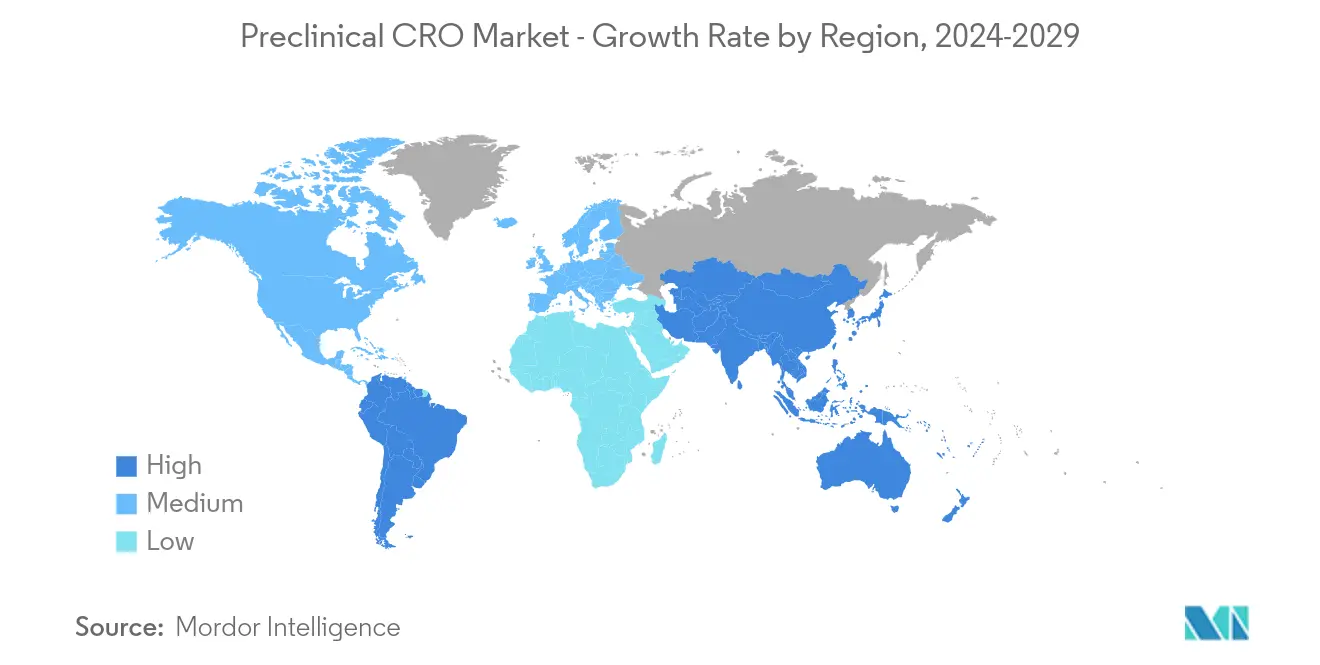
Competitive Landscape
The global market is very competitive, with most market leaders and players competing to maximize their market shares. Key players in the preclinical CRO market research are Charles River Laboratories, Labcorp Drug Development, Thermo Fisher Scientific Inc. (Pharmaceutical Product Development (PPD)), NorthEast BioAnalytical Laboratories LLC, Parexel International Corporation, Medpace, Eurofins Scientific, WuXi App Tec, ICON PLC, SGS SA, PharmaLegacy Laboratories, and Altasciences Company Inc., among others.
Currently, several major players offer significant research services and expand their clinical research support to the CRO industry, which is beneficial in various preclinical studies. With the emergence of advanced services, the market value of these key players increases, ultimately accentuating the competition.
For instance, in October 2023, Altasciences completed its laboratory facilities in Columbia, Missouri. This will supplement the service offering already available at Altasciences’ site in Seattle, Washington, to support preclinical and clinical studies conducted in the United States.
Consequently, strategic expansions by key companies are set to drive market growth and influence market trends during the forecast period.
Preclinical CRO Industry Leaders
-
Labcorp Drug Development
-
Eurofins Scientific
-
WuXi App Tec
-
SGS SA
-
Charles River Laboratories
- *Disclaimer: Major Players sorted in no particular order
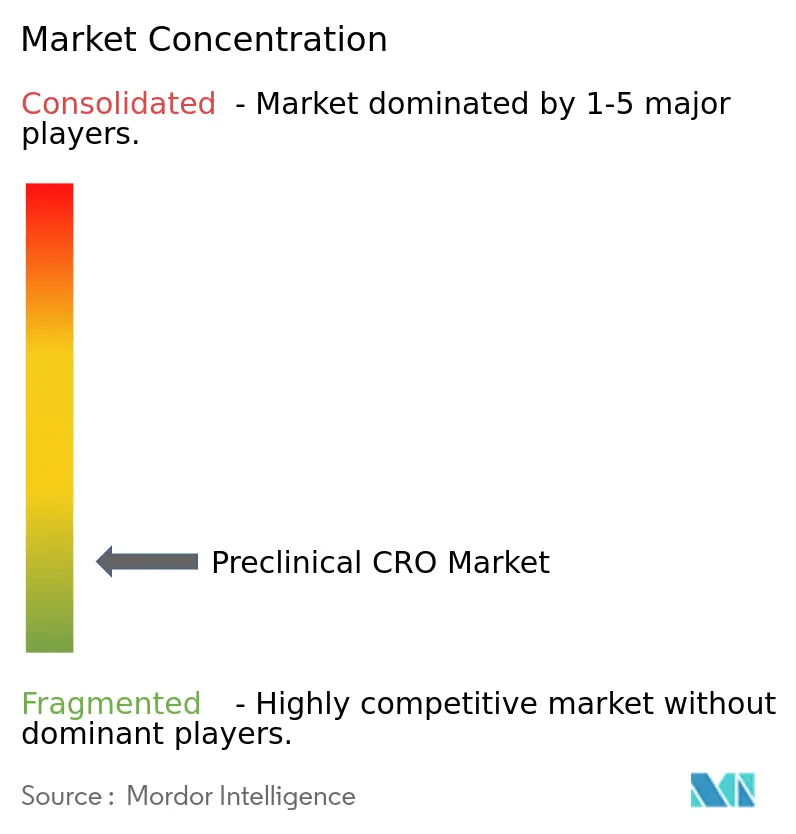
Recent Industry Developments
- August 2024: Silo Pharma, Inc., a biopharmaceutical company collaborated with WuXi AppTec (Hong Kong) Limited, a prominent global contract research organization (CRO). This partnership centers on a preclinical small animal study for SPU-16, a peptide designed to target the central nervous system (CNS) and aimed at addressing multiple sclerosis (MS). Furthermore, Silo Pharma is propelling the SPU-16 liposomal homing peptide's development, backed by a commercial evaluation license and option agreement with the University of Maryland, Baltimore (UMB).
- March 2024: PsychoGenics Inc., a contract research organization (CRO) specializing in the central nervous system (CNS) focused preclinical and translational drug discovery services, is pleased to introduce its updated corporate identity and brand. This rebranding highlights the company's extensive knowledge and tailored solutions aimed at uncovering innovative CNS treatments for biopharmaceutical firms, government entities, and disease research organizations.
- January 2024: Frontage Laboratories acquired Accelera S.r.l.’s Bioanalytical and DMPK businesses. Through this acquisition, Frontage Laboratories leverages preclinical studies services and clinical bioanalysis services offered by Accelera to increase its customers in Europe.
- November 2023: Ichor Life Sciences, a comprehensive contract research organization (CRO) and a pioneer in longevity biotechnology, unveiled its new venture: Ichor Clinical Trial Services. With the establishment of Ichor Clinical, the company extends its expertise, catering to biotechnology and pharmaceutical clients and guiding them from initial preclinical studies to advanced clinical trials and FDA approvals.
Global Preclinical CRO Market Report Scope
As per the scope of this report, preclinical contract research organizations (CROs) specialize in ensuring a seamless procedure with reliable results for each test. Prior to entering clinical trials (or receiving other approvals like 510Ks) or being used for human care, preclinical CROs assist new medical product developers in demonstrating their products' safety and efficacy in live models that the FDA considers approximate as closely as possible the human anatomy.
The preclinical CRO market is segmented by service, mode type, end users, and geography. By service, the market is segmented into toxicology testing, bioanalysis and drug metabolism and pharmacokinetics studies, safety pharmacology, and other services. By mode type, the market is segmented into patient-derived organoid (PDO) models and patient-derived xenograft (PDX) models. By end user, the market is segmented into biopharmaceutical companies, research institutes and universities, and other end users. By geography, the market is segmented into North America, Europe, Asia-Pacific, Middle East and Africa, and South America. The market report also covers the estimated market sizes and trends for 17 countries across major regions globally. The report offers the value in USD for the above segments. The report offers the value (in USD Billion) for the above segments. By Service Bioanalysis and Drug Metabolism and Pharmacokinetics Studies Safety Pharmacology Other Services By Mode Type Bioanalysis and Drug Metabolism and Pharmacokinetics Studies Safety Pharmacology By End Users Biopharmaceutical Companies Research Institutes and Universities Other End Users By Geography North America United States Canada Mexico Europe Germany United Kingdom France Italy Spain Rest of Europe Asia Pacific China Japan India Australia South Korea Rest of Asia Pacific Middle East & Africa GCC South Africa Rest of Middle East & Africa South America Brazil Argentina Rest of South America
| Toxicology Testing |
| Bioanalysis and Drug Metabolism and Pharmacokinetics Studies |
| Safety Pharmacology |
| Other Services |
| Patient Derived Organoid (PDOs) Models |
| Patient-derived Xenograft (PDX) Models |
| Biopharmaceutical Companies |
| Research Institutes and Universities |
| Other End Users |
| North America | United States |
| Canada | |
| Mexico | |
| Europe | Germany |
| United Kingdom | |
| France | |
| Italy | |
| Spain | |
| Rest of Europe | |
| Asia-Pacific | China |
| Japan | |
| India | |
| Australia | |
| South Korea | |
| Rest of Asia-Pacific | |
| Middle East and Africa | GCC |
| South Africa | |
| Rest of Middle East and Africa | |
| South America | Brazil |
| Argentina | |
| Rest of South America |
| By Service | Toxicology Testing | |
| Bioanalysis and Drug Metabolism and Pharmacokinetics Studies | ||
| Safety Pharmacology | ||
| Other Services | ||
| By Mode Type | Patient Derived Organoid (PDOs) Models | |
| Patient-derived Xenograft (PDX) Models | ||
| By End Users | Biopharmaceutical Companies | |
| Research Institutes and Universities | ||
| Other End Users | ||
| Geography | North America | United States |
| Canada | ||
| Mexico | ||
| Europe | Germany | |
| United Kingdom | ||
| France | ||
| Italy | ||
| Spain | ||
| Rest of Europe | ||
| Asia-Pacific | China | |
| Japan | ||
| India | ||
| Australia | ||
| South Korea | ||
| Rest of Asia-Pacific | ||
| Middle East and Africa | GCC | |
| South Africa | ||
| Rest of Middle East and Africa | ||
| South America | Brazil | |
| Argentina | ||
| Rest of South America | ||
Key Questions Answered in the Report
How big is the preclinical CRO market?
The preclinical CRO market size is estimated at USD 7.63 billion in 2025, and is expected to reach USD 10.92 billion by 2030, growing at a CAGR of 7.44% during the forecast period (2025-2030).
What is preclinical CRO?
Preclinical Contract Research Organizations (CROs) play a pivotal role in the early stages of drug development, conducting evaluations and tests prior to clinical trials. Catering to pharmaceutical and biotech firms, these CROs offer vital services, including project management, toxicology studies, safety assessments, and ensuring regulatory compliance.
Who are the leading players in the preclinical CRO market?
Key players include Eurofins Scientific, Charles River Laboratories, WuXi Apptec, Labcorp Drug Development, and SGS SA among others.
What challenges does the preclinical CRO market face?
The challenges faced by the preclinical CRO market are a lack of standardization and monitoring issues coupled with stringent regulatory policies.
What innovations are emerging in the preclinical CRO space?
The emergence of artificial intelligence, automation, and advanced bioanalytical techniques are a few of the advanced innovations in the preclinical CRO space.
Page last updated on:
